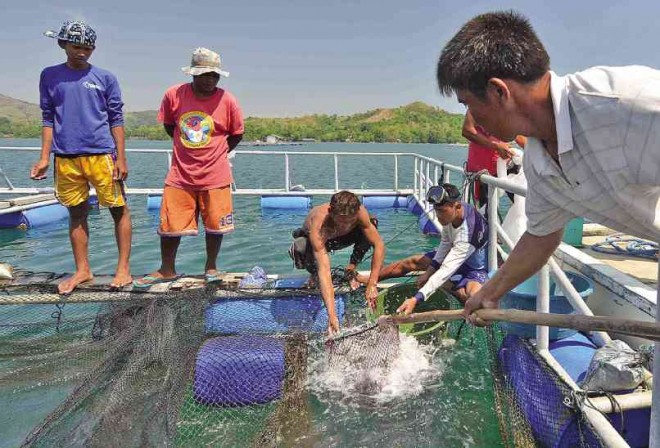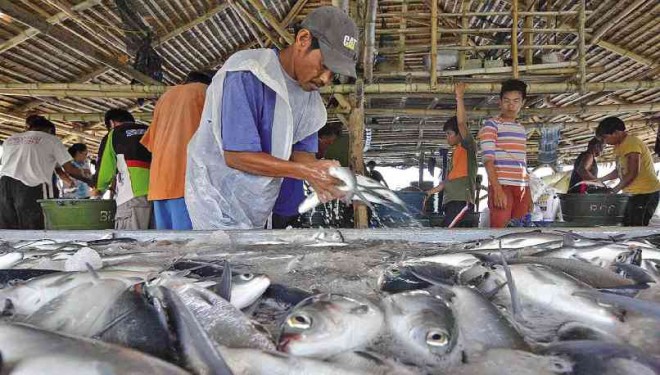Squeezing in fish cages in Kakiputan Channel
IN THE MIDDLE of Kakiputan Channel, an aquaculture area in Bolinao town in western Pangasinan, stands a shack built atop a fish cage.
A caretaker and his family live there because they are tasked to care for thousands of cultured “bangus” (milkfish). They also make sure no fish escapes their cages.
Over a hundred such caretaker families live on the Kakiputan Channel, a 7-kilometer stretch of water shared by Bolinao and neighboring Anda town.
Kakiputan Channel, according to the Bureau of Fisheries and Aquatic Resources (BFAR), has been populated with 281 cages and 325 pens, less than the number of structures during the industry’s early years when almost a thousand structures crowded the area.
The channel has been hosting cages for 20 years in a win or lose economic contest.
Article continues after this advertisementIt is Mother Nature, however, which seems to have the upper hand in the game, providing lessons through fish kill episodes and the frequency of red tide that have become yearly occurrences.
Article continues after this advertisement“Whatever you earn in two years could be wiped out in two hours of fish kill,” said Alaminos City Mayor Arthur Celeste, one of the pioneers of the aquaculture industry in the town.
The aquaculture industry here began in the late 1990s, a period of euphoria for the Bolinao community which fought to stop a proposed billion-dollar cement plant project in their midst.
The town’s marine environment was relatively pristine at that time and the residents fiercely defended it against the
potentially destructive project.
But an equally dangerous “invader” slowly crept into the town. Investors found Bolinao’s sea spaces ideal for culturing fish in pens near the shore. Soon, hundreds of fish cages were introduced in deeper parts of the sea for which the town has become known.
Fish kill
In February 2002, a massive fish kill devastated the industry with losses estimated at P400 million. Fish kills of lesser magnitude occurred in the following years, the most recent was in April this year which resulted in damages worth P200 million.
Heeding the lessons from the 2002 fish kill, local governments, aided by the scientific community led by the BFAR and the University of Marine Science Institute, came up with an aquaculture management system.
The system measures the appropriate stocking density and the sustainable number of fish pens and cages. It also provides feeding protocols so commercial feeds are not wasted and do not pollute the water.
“During the industry’s first 10 years, the operators made it big. So the number of operators increased. They put more structures and stocked them beyond the recommended stocking density. Now, we are victims of our own doing,” Celeste said.
The years of aquaculture has resulted in three meters deep of organic materials like uneaten feeds and bangus’ waste products.
Stock down
Celeste said operators used to stock up to 40,000 bangus in a cage and harvest them within 3 to 4 months.
Now the stock is down to 20,000 bangus for each cage and the culture time is up to seven months before the fish are harvested.
Red tide affects shellfish gatherers who could not gather and sell shellfish for months, or until the BFAR declares the area free of the scourge, Celeste said.
“Let us discipline ourselves. If BFAR says the Kakiputan can accommodate only 400 structures, there should only be 400,” said Celeste.
Plate numbers
Sual is a Johnny-come-lately in the
industry, starting only when Alaminos City Mayor Hernani Braganza stopped aquaculture in the city when he became mayor in 2004.
The displaced operators asked Sual government to accommodate their structures. There are 750 fish cages in the town, the number specified in Sual’s fishery ordinance. Each cage carries a plate number (similar to vehicles’ plate number).
“That way, it is easy to know if a cage is illegal,” said Sual Mayor Roberto Arcinue.
The operators are required to get an environmental compliance certificate (ECC) from the Department of Environment and Natural Resources. Each cage is given an exact place (coordinates) in the sea and is not allowed to transfer anywhere.
Sual has also introduced floating feeds which stay above the water until eaten.
Heeding the negative experiences of Bolinao, Anda wants to clean its act.
Affecting other towns
Elizabeth Tomas, municipal agriculture of Anda, wants BFAR to study the economics of aquaculture, such as how many cages an operator can manage and identify areas no longer fit for aquaculture, among other things.
“Unlike Sual, our waters are shallow which is why we have ‘baklad’ (fish traps), and structures for growing ‘talaba’ (oysters) These impede water flow,” she said.
Another neighbor town, Bani, has no aquaculture industry, but it shares Tambak Bay with Anda, Bolinao and Alaminos City.
“We have no pens and cages,” Bani Mayor Gwen Yamamoto said. But 300 kilos of wild fish floated dead in Bani River three weeks ago.
“What one town does affect another town,” she said, asking the neighbor towns to manage their aquaculture industry well so the neighbor towns won’t get affected.
One problem identified by the mayors was the presence of fish traps in Tambak Bay, which hampers navigation and impedes water flow in the area.
“The structures have invaded almost all of the space in the bay that passing through is like going through a zigzag road in the middle of the sea. The area has become smelly because of rotting organic materials,” Celeste said.
Dismantle
The officials of the four local governments have agreed to dismantle the structures.
BFAR Director Asis Perez said there was a need for proper management and regulation and good aquaculture practices to enable the operators to continue earning, and contribute to the country’s food security.
“We cannot take for granted the aquaculture industry of Pangasinan which produces 15 percent of the country’s fish production,” he said.


